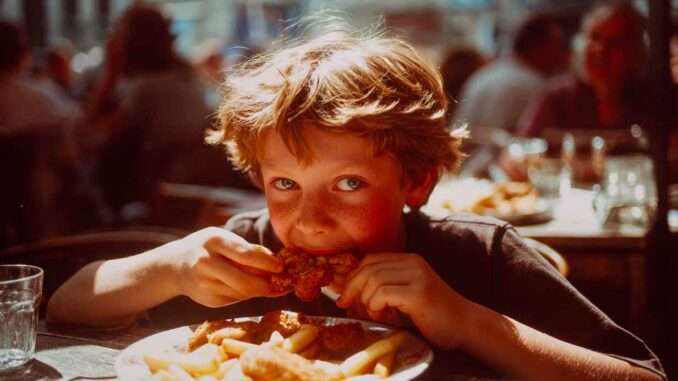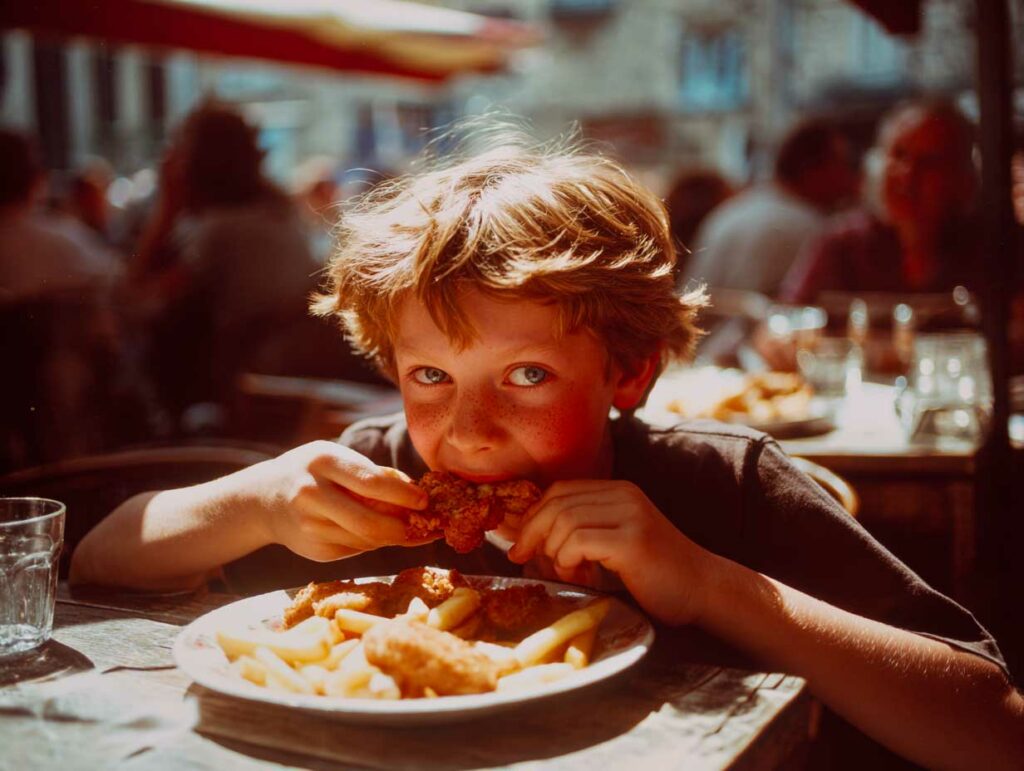
Inside classrooms, canteens and homes, France teaches children taste, texture and gastronomy through standards, sensory lessons and family rituals that endure.
France treats food as culture and curriculum. Children encounter taste at school through national standards that shape balanced menus, minimum eating times and sensory workshops. They meet producers during annual events and learn why bread and water are free while sauces are not. They also explore a weekly vegetarian offer now anchored in law. At home, the family table remains the main classroom: set mealtimes, a mid-afternoon goûter, repeated exposure to new textures and small jobs in the kitchen. This article explains the policies behind school meals, the techniques used to train the palate, and the practices that link school and home. It gives concrete figures, such as the 30-minute minimum eating time and the 50% sustainable purchasing goal in public catering, and describes how vocabulary, rituals and repetition help French children build confident, curious eaters.
The national framework that shapes taste education
France does not leave food education to chance. The Ministry of National Education sets broad aims for “éducation à l’alimentation et au goût,” which runs through the curriculum from early years to secondary. The canteen is part of the lesson. A typical school lunch must include four or five components: a main course, a side, a dairy product, and either a starter or a dessert. Water is the only recommended drink and must be freely available; bread must also be available without restriction; salt and sauces are not self-serve. A minimum of 30 minutes is reserved for eating, excluding queuing. These rules make lunch a calm space for sensory learning rather than a race against time.
Behind the scenes, buyers and caterers use the GEM-RCN guidelines to plan frequencies and portions over menu cycles. Annexes specify how often raw fruit must appear, how many meals include cooked vegetables, and how dairy ensures calcium coverage. This technical backbone allows schools to vary products by season while keeping nutrition predictable and safe. It also creates a shared language among teachers, cooks and parents.
The vegetarian shift and sustainable sourcing
France’s “Égalim” reforms have reshaped public catering. All school canteens must now offer at least one menu végétarien per week. The requirement, piloted in 2019 and made permanent in law in 2021, aims to diversify proteins and reduce environmental impact without lowering nutritional quality. Separately, public caterers must reach at least 50% sustainable or quality-labelled products, including 20% organic, with some regions now moving to higher targets. These rules have practical effects on a child’s tray: more legumes, more seasonal vegetables, and more attention to provenance. They also encourage schools to present pulses and grains in familiar formats—lentil salads, chickpea panisses, or gratins—so taste drives acceptance.
The school canteen that trains the palate
The school meal operates as a daily tasting class. A typical service might offer grated carrots with vinaigrette, a fish fillet with rice, a side of green beans, plain yogurt, and a piece of fruit. Over a 20-meal cycle, caterers must hit targets for raw fruit, cooked vegetables, oily fish, and calcium-rich dairy. Bread and water are deliberately simple. Children learn to identify hunger and satiety without sweet drinks to distract them. The 30-minute eating time matters: studies show that when time drops, vegetable intake falls first.
Sensory education is built into the calendar. The nationwide Semaine du Goût mobilises chefs, farmers and teachers each autumn for classroom tastings and field visits. Many schools run “Leçons de Goût,” short workshops that compare textures and aromas using apples, cheeses or herbs. Bread is a frequent teaching tool: children sniff crusts, touch crumb, taste differences between pain de campagne and baguette. The aim is not luxury; it is vocabulary. Children learn to say acidulé, amer, croquant, fondant. Language anchors experience.
The classroom that builds food literacy
Teachers extend the work beyond the dining hall. In primary school, the “goût” lesson uses the five senses to decode food. A simple grid—color, smell, texture, sound, taste—helps pupils describe strawberries, radishes or yogurts before they ever say “I don’t like it.” The historical approach enters as well: why Roquefort is blue, why lentilles vertes du Puy keep their shape, why regional names signal techniques. Science classes link microbes, fermentation and safety. Geography links products to terroirs. Older pupils look at labels, sugar and salt thresholds, and energy balance.
Waste reduction is a second thread. Schools measure what returns to the kitchen, adjust portion sizes by age, and trial service tweaks—cut fruit for younger children, sauce served by an adult—to reduce leftovers. Menu boards display the week’s dishes and sometimes the farm or fishing zone. These small cues align canteen practice with classroom messages about sustainability, seasonality and health.

The family table that completes the lesson
At home, the family table is where taste becomes habit. French families typically organise three meals and a mid-afternoon goûter. The goûter—often fruit, dairy and a small cereal item—accounts for about 10–15% of daily energy and bridges the gap between school and dinner. Parents commonly post or check school menus, then complement them at home: fish at lunch, pulses at dinner; dairy at lunch, fruit at snack. This coordination prevents duplication and keeps variety high across the day.
Two tactics help with picky phases. First, repeated exposure: a new vegetable might need eight or ten tries, with tiny portions, different cuts, and varied textures. Offer raw carrot batons one week, thin coins glazed the next, and a purée later. Second, small jobs: children wash salad leaves, spin them dry, or whisk vinaigrette in a jar. The task builds ownership and increases the chance they will taste the result. Families also borrow school rituals. Some serve starter-main-dairy-fruit on weeknights because small plates move faster and let vegetables lead. Others reserve one night for tasting: three apples sliced and compared, or two cheeses discussed for aroma and texture. The point is to convert curiosity into routine.
The heritage that frames everyday meals
The Repas gastronomique des Français is inscribed on UNESCO’s list of intangible cultural heritage. It formalises ideas already present at family tables: a sequence of dishes, attention to presentation, and the pleasure of taste shared across generations. Schools quietly echo this structure with their multi-component lunches. Children learn that a “balanced” meal is not a nutrient spreadsheet; it is a composed sequence where each item has a role. That sense of order—starter to dessert, bread and water as constants—travels back home and stabilises mealtime expectations.
Civic actors amplify the message. The Classes du Goût, first created in the 1970s by Jacques Puisais, survive in updated forms through local projects and teacher training. Chefs visit schools; pupils visit farms; municipalities post sourcing indicators alongside menus. France’s culinary diplomacy, from “Goût de/Good France” events to the work of national ambassadors for gastronomy, keeps food culture visible and aspirational for children who may never set foot in a starred restaurant.
The measures that make standards tangible
Numbers keep the system honest. Schools must reserve at least 30 minutes for eating. Lunch should deliver about 40% of daily energy, with breakfast at 20%, the goûter near 10%, and dinner around 30%. Over each menu cycle, raw fruit and raw vegetables must appear at defined frequencies; oily fish must appear at least several times; dairy rich in calcium must hit minimum counts. Bread and tap water are unlimited; sweet drinks are discouraged. Since 2021, at least one weekly vegetarian menu is mandatory in all school canteens, and public catering must reach 50% sustainable or quality-labelled products, including 20% organic. These figures are not decoration; they create predictable exposure to diverse tastes and textures for every child, regardless of family means.
The bridge between standards and appetite
France’s system works because it makes the “why” visible. Children see rules on the wall, taste them at lunch, and hear them explained in class. At home, parents see menus online and adjust dinner without guesswork. The result is not uniform taste; it is confidence. A child who has peeled a carrot, tasted a lentil three ways, and sat through a calm 30-minute lunch knows that flavor takes time and attention. That knowledge is a better predictor of lifelong curiosity than any single dish.
Cook in France is your independant source for food in France.